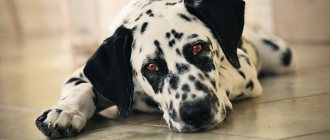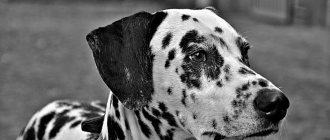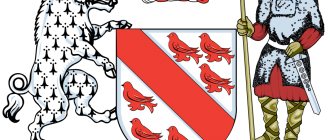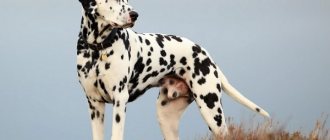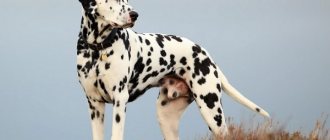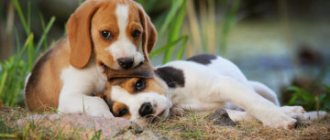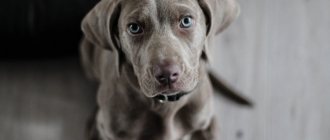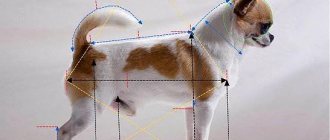Bred in Croatia as hunting and family dogs, Dalmatians have an unusual coat color that makes them impossible to confuse with anyone else. Black spots scattered on a snow-white background are the hallmark of Dalmatians. But sometimes you can hear that a brown or even black representative of the breed was seen somewhere. Could this be true? Let's figure it out.
History of Dalmatians
The breed is considered very ancient, so its exact origin remains a mystery. Based on historical facts, researchers put forward many versions, but none have been confirmed.
Images of spotted dogs bearing a striking resemblance to modern Dalmatians are often found among ancient artifacts in Mediterranean countries, India and Egypt. These are figurines, drawings, reliefs dating back to 4,000-1,100 BC. e.
Animals are mentioned with descriptions of the breed in the works of several philosophers from the first millennium BC. e. Surprisingly, starting from the 1st century, information about Dalmatians has not been found in any of the historical sources.
Origin story
The history of the breed remains unknown today, causing controversy among professional breeders. Traditionally, Dalmatia, which belongs to modern Croatia, is considered the place where Dalmatians were bred. The animals were born by crossing a Great Dane and an English Pointer. Archival documents from the 18th century confirm that in this territory breeders were actually breeding dogs with rare colors. Back then they were used mainly for hunting.
There is a theory according to which the first Dalmatians appeared in Ancient Egypt. This is confirmed by the drawings found on the pyramids. They depicted dogs resembling modern Dalmatians in appearance. This version is supported by their ability to tolerate heat well in the summer.
Since the beginning of the 18th century, dogs began to be used as guards, protecting carriages from robberies and wild animals. Therefore, the animal was called a carriage dog.
Many dog lovers do not know the correct name of the breed: Dalmatian or Dalmatian. The official name is Dalmatian, but at the level of spoken language the first option has taken hold.
Origin of the name of the breed
More recent evidence is found in medieval Croatia (province of Dalmatia on the Balkan Peninsula). Images of Dalmatians, starting from the 13th century AD. e., are present on ancient ceramics, coats of arms of cities and nobility, paintings. There are also several descriptions of a white individual covered with black dots, dating back to the 13th – 18th centuries.
A document dating back to 1374 even mentions a nursery in Dalmatia that housed 500 Canis Dalmaticus. This means that the breed could get its name from the name of this historical region.
Another version of the origin is that for the first time in Europe, a resident of Serbia, Yuri Dalmatin, began breeding the animal at the end of the 16th century. He received as a gift several individuals brought from Bohemia.
In 2010, the version about the Croatian origin of dogs was officially adopted.
Price
The price of a puppy depends on the characteristics and pedigree of the dog. For an animal without documents, the cost varies from 4,000 to 8,000 rubles. Based on individual characteristics and the breed standard, the price starts from 15,000 rubles and reaches $1,000 or more.
Where to buy a puppy in Russia?
- Nursery in the Moscow region Symphony of stars (https://dalmatin-stars.ru/).
- The Auroras Moon nursery operates in the Krasnodar region (https://aurorasmoon.ru/).
- The nursery “From the Nevskie Islands” is located in St. Petersburg. It is the only specialized breed nursery in the city. (https://dalmatian-spb.ru/pitomnik.htm).
Description and breed standards
A healthy Dalmatian has developed and strong muscles, is hardy and active. There is no clumsiness or sluggishness in the dog’s movements. The dog's leg joints have a special angle of inclination and correct balance, due to which when running the Dalmatian makes powerful and at the same time smooth jerks and is able to cover distances of many kilometers.
Color
There are no two identically colored individuals: some are almost white, with several small dark specks, and others are light with specks barely visible through the black merging spots. The dots on the fur of Dalmatians can be large or small, evenly scattered over the body or connected into a continuous dark surface.
According to the breed standard, two types of dog colors are allowed:
- black and white;
- brown-white.
The spots are round in shape, evenly pigmented, 2-3 cm in diameter. The location is uniform, but on the paws, head and tail of the Dalmatian they are smaller and less common.
Weight and size
Sexual dimorphism is clearly expressed. Clear standards for Dalmatian weight and height have been officially defined:
- Male weight – 27-32 kg, height at withers 56-61 cm.
- The bitch looks more graceful and thinner. Adult size: 54-59 cm, weight – 24-29 kg.
Dogs can weigh significantly more than the upper limit of the standard. This is acceptable if the Dalmatians have the correct proportions.
Wool
Dalmatians are a short-haired breed. Dogs' coat is thick, dense and shiny, smooth and even to the touch. There is no undercoat.
Breed physique
The body proportions of a Dalmatian are clearly regulated by standards:
- The dog's head is elongated and has the shape of an even wedge. The forehead is wide, slightly rounded, with a groove in the middle. Cheekbones are pronounced. The lips do not sag, they are dry, there should be rich pigmentation along the outermost line. The skin is taut, without folds. The bridge of the nose is straight. The length of the muzzle and the rest of the Dalmatian skull are the same.
- The dog's ears are in the shape of triangles, wide at the base, with rounded ends, lowered towards the head when at rest, and turned forward when aggressive. The cartilage is thin and soft.
- Dalmatians' teeth are white, even, the bite is tight, without gaps.
- The dog's nose is large and wide, colored to match the spots on the body, and the nostrils are open.
- The dog's eyes are oval-shaped and shallow-set. The eyelids do not sag and have an edging that matches the spots. The iris is brown (light or dark).
- The neck is long, without dewlap, with a smooth bend. Widens towards the shoulders, narrows towards the head.
- The body of the Dalmatian is streamlined, slightly rounded. The withers are raised. The groin is tightened. The croup has a slight slope. The dog's chest is of medium width, deep, the lower part is at the level of the elbows. The ribs are proportional and rounded.
- The tail extends to the hocks, thicker at the base and thinner at the tip. It does not twist, but only rises slightly while walking. Straight (let's say a small crease by a third).
- Dalmatians' limbs look perfectly straight. The elbows are pressed to the sternum, the muscles appear. The toes are not splayed, the nails are white or pigmented.
The ratio of the proportions of the length and height of the body of the Dalmatian is 10/9.
Which dogs are culled?
A fairly large number of animals (about 13%) have deviations from accepted breed standards, due to which they are not allowed to participate in exhibitions and breeding:
- Dalmatian puppies are not born white, but with congenital spots. A specialist can identify them even in an adult: they are large in size and solid black in color, without light hairs. Wool is usually softer and silkier to the touch.
- In a few individuals, the spots become gray or bronze in color (yellow, red or light brown) with age. Only Dalmatians with black and brown spots can be registered.
- Blue eye color. This defect in a dog is detected on days 12-16.
- Not colored nose (more than 5%) or eyelid rims. The disorder occurs in many dogs, and if it does not disappear with age, he will be disqualified.
- Tricolor Dalmatians.
- Almond-shaped eyes, a thorn in the dog.
- Malocclusion in a dog.
- The dog's character should not be too timid or aggressive.
Expert opinion
Anna Abramenko
An avid dog lover. Experience in veterinary medicine since 2009.
Ask a Question
Such animals are not suitable for exhibition or breeding, but will make excellent pets.
Description of the Dalmatian dog breed
Contrasting spotted color and aristocratic physique are the distinctive features of the Dalmatian breed. The dog’s bright exterior will attract the eyes of others to your pet, no matter where you appear with it. The popularity of the breed is incredibly high. The film adaptation of the fairy tale novel “101 Dalmatians” by British writer Dodie Smith played a major role in popularizing the breed.
The world first saw the story of 101 puppies in the cartoon genre in 1961. Mankind had the opportunity to meet their favorite characters for the second time in 1996, when Walt Disney Studios made a live-action film based on this work. We continued our acquaintance with charming black and white dogs in the animated series, which was filmed as a continuation of the film in 1997-1998.
The Dalmatian is a big dog. This fact, combined with his graceful physique, makes him even more impressive and noticeable. The height of a male Dalmatian at the withers can reach 62 cm. The height at the withers of a female Dalmatian is slightly different - 58-60 cm. The weight of an adult Dalmatian is 25-28 kg.
Purpose of the breed
Over the centuries-old history of the existence of Dalmatians, people have found different uses for them. And four-legged friends have always justified the trust placed in them.
In the 18th century in England, Dalmatians received the nickname “coach dog”. Several Dalmatians accompanied the carriages, clearing the road and urging the horses on. The aristocratic and elegant appearance made the animal incredibly popular among the nobility. Numerous nurseries were created in the country and the colonies, which almost led to the degeneration of the Dalmatian breed. Gradually, carriages were replaced by cars, and the need for a canine escort disappeared.
The breed has been widespread in America since 1800. Dalmatians are known to have been used as fire sirens. A pack of barking dogs cleared the streets of passers-by in front of a cart on its way to a call.
Dalmatians are highly trainable and distinguished by their artistry, which is why in the 18th and 19th centuries they were participants in circus performances.
The British attracted smart and obedient animals to serve in the police, used dogs for hunting, as shepherds, and security guards.
Application
As society developed and progressed, the functions of dogs changed. They have hunting skills, a developed guard instinct and are devoted to people.
- Initially, Dalmatians were used to guard cargo during travel. They urged stubborn horses. A pack of such dogs could even cope with large wild animals that stood in the way.
- In addition, Dalmatians were used as hunting dogs and for herding livestock.
- In America, white spotted animals were perceived as a warning about the movement of the fire brigade. Until now, in this country they are a mascot for firefighters.
- Currently, the breed is bred as a companion dog. It is ideal for a large family with children.
Character
Dalmatians are distinguished by active social behavior. Dogs are ready to take part in all family affairs, they are cheerful and cheerful. Dogs are incredibly loyal to their owner: the highest reward for an animal is to earn praise and approval. Dalmatians love children, but due to their large size they can accidentally cause harm (push, knock down, pull on the leash). The dog does not show excessive aggression towards strangers and behaves restrained and wary.
Expert opinion
Anna Abramenko
An avid dog lover. Experience in veterinary medicine since 2009.
Ask a Question
The breed does not allow a rude and familiar attitude; Dalmatians are somewhat vindictive. The owner must immediately let the pet know who is boss in the house - male dogs tend to dominate.
To maintain the dog's vitality, normal physical activity and long walks are important. Dalmatians rarely speak, but they do an excellent job as guards.
Breeding
The first heat of a female Dalmatian occurs at 6-8 months. But the dog is lagging behind in growth and development, so mating must be waited until 1.5-2 years. Estrus occurs twice a year, lasting 3-4 weeks. Mating takes place in the male dog's territory.
Pregnancy in the breed lasts 61-65 days. The owner must carefully monitor the bitch and carefully organize the upcoming birth of the offspring (prepare the place, accustom it to it). Usually, Dalmatians give birth easily, but complications arise, including the need for a caesarean section.
A Dalmatian litter usually produces 6-10 snow-white puppies (the record is 18). Barely visible dark spots are visible in places where there is short hair: on the stomach, paw pads, nose, around the mouth. A few days later, the first dark spots appear all over the dog’s skin, which become brighter every day. By 3-4 months, the color of babies is completely formed.
Expert opinion
Anna Abramenko
An avid dog lover. Experience in veterinary medicine since 2009.
Ask a Question
Lack of mating will adversely affect the health of a Dalmatian of either sex. It is better to sterilize a non-breeding bitch.
Education and training
Even a beginner with no training experience can raise a Dalmatian. Animals are willing to make contact and easily absorb knowledge. Once learned, the dog will remember commands forever.
By 4 months, the Dalmatian should be able to walk on a leash, respond to the owner’s call, and learn a nickname. From 5-6 months. It's time to start training your dog. It will be much easier for a child to absorb knowledge if he has interest and incentive.
Effectively engage in groups - Dalmatians are able to imitate. Thanks to ingenuity and a good memory, the pet will be able to master the training course and gradually learn to perform complex tricks.
Expert opinion
Anna Abramenko
An avid dog lover. Experience in veterinary medicine since 2009.
Ask a Question
Dalmatians cannot be kept in an enclosure or on a chain (they can be walked on a leash). The breed gets along well with other domestic animals; friction arises only between two dominant males in a small area.
Care and maintenance
Dalmatians are successfully kept in apartments and private houses, despite their impressive size. The dog easily moves in space without destroying furniture.
Seasonal shedding is not typical for the dog, so every 1-2 days throughout the life of the Dalmatian, the fur should be combed with a soft brush. The dog's skin should be regularly examined for inflammation and parasites.
Your dog's ears require frequent inspection. The norm is a small amount of light-colored sulfur. If there is an odor, redness, or excessive discharge, your pet should be shown to a veterinarian.
From an early age, dogs begin to have their nails trimmed, gums treated, and tartar removed.
The pet will have to be bathed frequently - any minor dirt will be visible on the white background. But it is recommended to wash your dog with special shampoos no more than 2-3 times a year. Dalmatian skin is prone to irritation and allergies, so hygiene products are selected especially carefully.
Non-standard colors of Dalmatians - uniqueness or breed defect
Black and white and brown and white are all colors allowed for the Dalmatian breed. All other color options that unscrupulous breeders try to pass off as rare and unique are breed defects. Let's talk in more detail about what non-standard colors of Dalmatians can be found.
- Bronze. Bronze spots are a fault in the breed. It appears against the background of shedding, poor nutrition, and coat diseases. This is a temporary phenomenon in both black and white and brown individuals. Loss of pigmentation causes black spots to fade and take on a rusty or hazel color, while brown spots fade to rusty brown, orange, or lemon.
- Tricolor. This is a serious disqualifying fault. It is expressed by the constant presence of spots of two colors on the body of one dog. Black and white Dalmatians may have brown, brindle, yellow or tan markings. Brown tricolor Dalmatians have additional orange and tan markings. Spots of atypical color most often appear on the dog's chest, face and limbs. The complexity of this color lies in the fact that spots of the second shade do not appear immediately, but after 2-3 months. Therefore, you can purchase a puppy without a defect mark.
- Citric. A rare color defect looks like lemon or orange spots on a white background. The color of these Dalmatians can be compared to the color of Golden Retrievers. These dogs look very beautiful, but this color is a serious disqualifying fault. It is important not to confuse the sun-bleached spots of an adult Brown Dalmatian with natural lemon spots.
- Brindle. Another beautiful breed marriage. The spots in this case have a tiger tint.
- Asphalt. A rare color, considered a disqualifying fault. In this case, the black spots, due to a pigmentation disorder, acquire an asphalt tint.
- Peach. One of the types of pigmentation disorders in brown and white dogs. The spots on the animal's body are pale brown, peach or pale orange.
- Lightened. Dogs with this color defect are found among monochrome representatives. Due to a genetic mutation, their black spots appear gray-blue. These puppies look beautiful, so breeders often inflate their prices.
Important: Brown individuals never have black pigment.
How the color of a Dalmatian is formed - genetics
Genetics is responsible for the color of a dog’s coat, namely the presence of certain genes in the father and mother of the puppy. Let's consider how the color of the offspring depends on what genes the parents have. This will help us understand that the “rainbow Dalmatian” color is impossible in nature.
So, the inheritance of non-standard colors in the Dalmatian dog breed occurs through recessive (non-dominant) genes. That is, for a puppy to develop an exotic color (not recognized by breed standards), these genes must be present in both parents.
Let's look at which genes are responsible for the color of Dalmatians:
- As – a gene that is responsible for ensuring that a dog’s spots are uniform;
- Bb – in this gene, the capital letter B denotes the dominant black color, and the small letter b denotes the recessive brown color;
- Ee - in this genome, the large E denotes the black pigment, and the small e is responsible for the recessive yellow pigment;
- at is the genome that is responsible for the “tricolor”; in order for the tricolor color to appear in the offspring, both parents must have this gene;
- sw, T, F – genes responsible for the rich color of the spots and the speckled color of the hairs.
None of these combinations can create colored "rainbow" spots on a Dalmatian's white body. This is a fact, nothing can be done about it.
Rainbow Dalmatians
